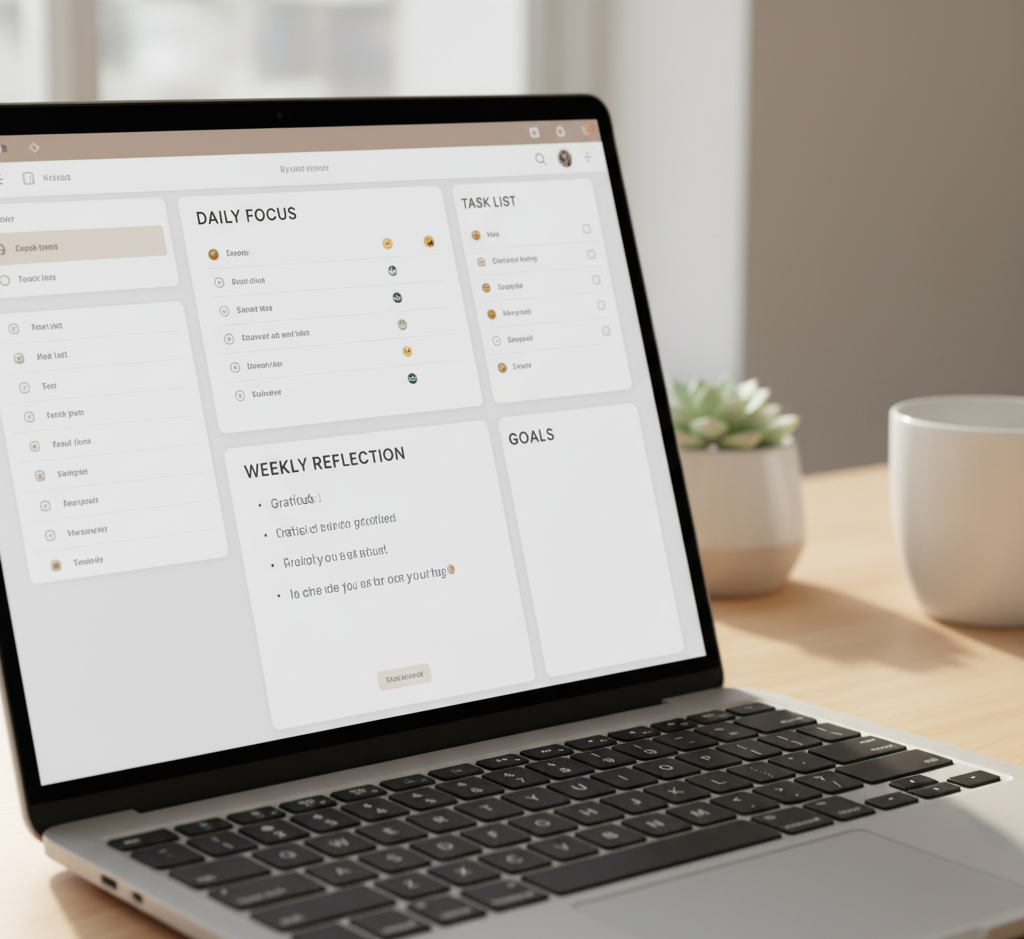Reclaim your focus, create flow, and get meaningful work done — without burnout.
Have you ever ended a week feeling busy… but not productive? The kind of week where you answered endless emails, checked off minor tasks, but never touched the thing that truly mattered? You’re not alone.
The modern workweek is full of noise — pings, messages, and endless small tasks pretending to be urgent. But what if you designed a week focused only on deep work — the kind of focused, uninterrupted effort that moves your goals forward meaningfully?
I’ve tried this experiment many times, and each time, I’m reminded that focus isn’t about discipline — it’s about design. When you plan your environment, schedule, and energy intentionally, clarity naturally follows.
This article walks you through exactly how to plan your own Deep Work Week — from setting boundaries and mapping tasks to building recovery and flow. Think of it as a blueprint for meaningful productivity — calm, sustainable, and deeply satisfying.
What Is a Deep Work Week?
Deep Work, a term coined by Cal Newport, is the practice of focusing without distraction on cognitively demanding tasks. A Deep Work week, then, is a period intentionally structured around depth — not busyness.
It’s less about working more and more about working better. During a Deep Work Week, you intentionally minimize shallow tasks, create time blocks for focus, and let yourself dive fully into important projects.
The goal: to produce work that’s both high in quality and personally meaningful — while reducing mental clutter.
Key takeaway: A Deep Work Week isn’t about doing everything — it’s about doing the right things with total presence.
Step 1: Set Your Deep Work Intentions

Before you schedule anything, start by clarifying why you’re doing this. Without intention, even the best schedule becomes another productivity hack that fades after a few days.
Ask yourself:
- What’s one meaningful outcome I want to create this week?
- Why does it matter to me?
- What would success look like — not in numbers, but in clarity or progress?
Write these down somewhere visible. You’ll come back to them when distractions appear.
A Personal Note
When I first planned my Deep Work Week, I overcommitted — three big goals, daily checklists, zero breaks. By midweek, I was exhausted. The turning point came when I scaled back to one key outcome. That focus made the entire process more sustainable — and satisfying.
Key takeaway: One deep goal done well beats five half-finished ones.
Step 2: Choose Your Deep Work Blocks

Once your intention is clear, it’s time to design your focus schedule.
Deep Work happens best in dedicated blocks — usually 90–120 minutes of uninterrupted focus.
Here’s how to map them:
Morning for Makers
The first 3–4 hours of your day often hold your peak cognitive energy.
- Schedule your most demanding work here.
- Protect this time — silence notifications, close tabs, and use “Do Not Disturb” modes.
Afternoon for Admin
After lunch, your energy naturally dips.
- Reserve this time for lighter tasks: planning, email, or meetings.
- Keep this period structured but less demanding.
Evening for Reflection
End your day by reviewing progress — not by doing more.
- Note what worked, what felt easy, and where your attention slipped.
- This reflection keeps your next day intentional.
Pro tip: Try using Notion or Todoist to visually plan and track your focus blocks. I use Notion to build weekly dashboards — it helps me see patterns in my energy and progress without overwhelming me.
Key takeaway: Plan your energy, not just your hours.
Step 3: Minimize Shallow Work (Without Guilt)

You can’t have deep work without managing shallow work — the admin, communication, and logistical tasks that fill your calendar. But you can contain them.
Here’s a simple system:
- Batch shallow tasks. Do all email, admin, and logistics in 1–2 time slots daily.
- Use templates. Pre-write responses or processes you repeat often.
- Automate what you can. Tools like Zapier or Sunsama can handle repetitive work.
- Set communication boundaries. Tell your team or clients when you’ll be offline for focus — and stick to it.
Most people underestimate how much shallow work drains creative energy. It’s not the time — it’s the mental context switching. Reducing this friction can free hours of hidden focus.
Key takeaway: Protect your attention as you would your most valuable asset — because it is.
Step 4: Design for Focus — and Recovery

Sustained deep work requires balance. You can’t focus deeply if you’re mentally cluttered or physically depleted. A Deep Work Week isn’t just about effort — it’s about recovery.
Create Rituals for Focus
- Start each deep session the same way (e.g., tea, playlist, closed tabs).
- Signal to your brain: this is focus time.
- Try ambient sound apps like Brain.fm or Noisli — subtle auditory cues can improve immersion.
Protect Rest as Part of Work
- Schedule daily “no-input” time — walks, journaling, or quiet breaks.
- Get enough sleep; no tool compensates for fatigue.
- Use evenings for recovery, not reaction (avoid checking Slack or email).
During my last Deep Work Week, I made a rule — no work after 7 p.m. The first two nights, I felt restless. By day three, I noticed sharper focus and calmer mornings. Depth comes not from effort, but rhythm.
Key takeaway: Rest isn’t a reward — it’s a requirement for sustainable depth.
Step 5: Eliminate Distractions Strategically

You’ve heard this advice before — but true focus isn’t about deleting distractions; it’s about understanding them.
Ask yourself:
- What pulls me away most often?
- When do I feel most tempted to check my phone or inbox?
- What need is that behavior trying to meet (comfort, connection, novelty)?
Then, design environmental solutions:
- Use website blockers (Freedom, Cold Turkey) during deep work blocks.
- Keep your phone in another room.
- Turn off visual badges or unread counts.
- Work in full-screen mode to reduce visual noise.
Deep work isn’t about rigid control — it’s about gentle boundaries that make focus the default.
Key takeaway: Make focus easier than distraction.
Step 6: Review and Reflect Each Day

Reflection transforms effort into insight. At the end of each day, spend five minutes reviewing:
- What did I focus on deeply today?
- What helped my concentration?
- What drained it?
Capture your answers in a short digital journal or inside a Notion tracker.
Weekly Reflection
At the end of the week, look for patterns:
- Which time blocks worked best?
- What shallow tasks crept in?
- What felt most meaningful?
Then, refine your next Deep Work Week plan.
This process compounds over time — the more you reflect, the better you design.
Key takeaway: Small reflections build lasting systems.
Step 7: Tools That Support Deep Work

You don’t need fancy tools to focus deeply — but a few can make the process smoother.
Here are some thoughtfully chosen options:
For Planning
- Notion – Custom dashboards for planning and journaling.
- Todoist – Simple, intuitive daily task tracking.
For Focus
- Forest – Gamifies phone-free time.
- Brain.fm – Music designed to support deep focus states.
For Reflection
- Daylio – Quick daily journaling for patterns.
- Obsidian – Ideal for deeper knowledge management.
I personally use Notion and Brain.fm together during my deep sessions — it’s a simple setup that keeps me both structured and grounded.
Key takeaway: The right tools should feel invisible — supporting clarity, not clutter.
Step 8: Protect the Transition Back

The end of a Deep Work Week is just as important as the start. If you jump straight back into chaos, the benefits fade.
Take one quiet morning to review your progress and integrate what you’ve learned.
Ask yourself:
- What felt easiest about this week?
- What surprised me?
- How can I carry this clarity forward into my regular routine?
After my first Deep Work Week, I tried to maintain the same level of focus indefinitely — and quickly burned out. The key was integration, not imitation. Now, I schedule a Deep Work Week once every quarter. It resets my attention and creativity better than any vacation.
Key takeaway: Deep work isn’t a sprint — it’s a practice of returning to depth.
Conclusion
A Deep Work Week isn’t about perfection. It’s about designing a rhythm that honors your best attention and deepest curiosity.
Main takeaways:
- Set one clear intention for your week.
- Design blocks that match your energy.
- Protect rest as fiercely as focus.
- Reflect often — because awareness drives growth.
If you want to organize your next Deep Work Week visually, try building a simple dashboard using Notion (affiliate link). It’s the best tool I’ve found for aligning clarity, structure, and reflection.
And if this article resonated with you, you’ll love my previous guide — Digital Declutter Checklist — a perfect companion for clearing your mental and digital space before starting your Deep Work Week.
Final thought: Deep work isn’t about doing more — it’s about being fully where you are.





